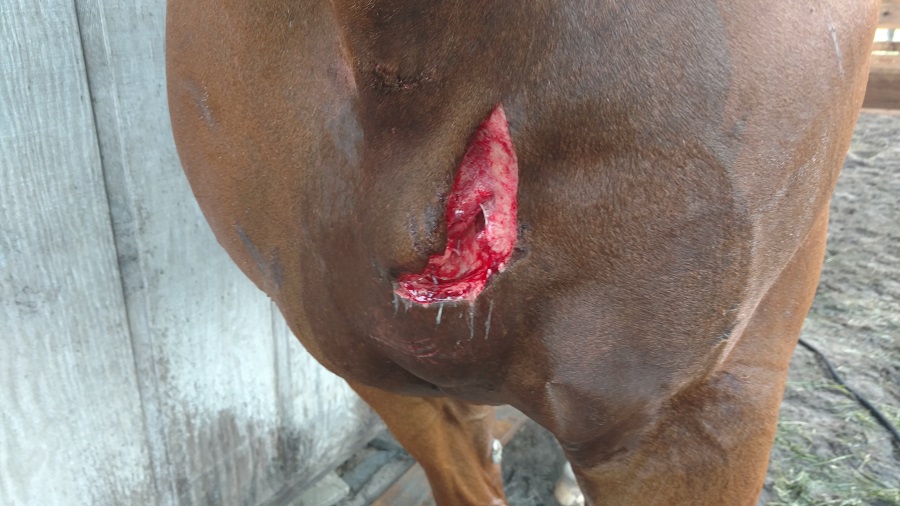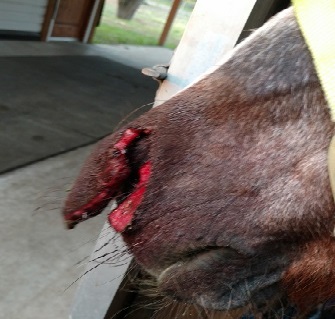Tuesdays with Tony
If you have been following the Springhill Equine Facebook page, and I know you have, you have probably seen the post about a couple of horses who took the opportunity this weekend to injure themselves. For some reason I think horses are feeling a bit restless with all this stay at home, self-quarantine, social distancing stuff. I have heard about several horses who have wounded themselves in one way or another since the start of all of this. I guess they must be experiencing stable fever. Don’t worry, you all will be back on the trails, headed to shows, and barrel races soon. In the meantime, let’s talk about what to do when your horse is the one experiencing stable fever and finds a way to injure himself.
So, you’ve been inside all day watching Netflix and you finally decide to spend some time outside with your horse only to find your horse has an open wound on his leg, or neck, or face, or really, just about anywhere. Oh, no! Now what do you do? Well, I know you all have downloaded the Medici App already, so you grab your phone and get ahold of one of my docs through Medici. They will look at the wound and determine if it needs to be seen.

Initial Treatment
My docs will probably tell you to go ahead and start running cold water over the wound. Remember, dilution is the solution to pollution. They will instruct you not to go exploring the wound. Vital structures may lay just below the surface and any type of probing may disrupt those structures leading to a life-threatening emergency for your horse. Depending on the injury, they may recommend moving your horse to his stall or a clean environment. However, sometimes it is best to not move your horse at all until my docs can assess the situation. This is why we love using telemedicine with Medici! My docs can really see the problem at hand in real time and get you the best advice for your horse before they even get there.
If it’s possible, my docs may recommend getting your horse a dose of bute or banamine to help with any swelling that is inevitably going to occur. Now that you have performed the critical steps in your horse’s wound care, sit tight and wait for the doc to arrive. I have heard this is the hardest part of all. I have no trouble sitting around all day waiting for dinner, so I am not sure what is so hard.
The Exam
Now that my doc has arrived, they will assess the situation. The first thing they will do is ensure that your horse is safe. They ask themselves several questions, including how much blood has been lost, is the horse in shock, how long ago does it appear the injury has happened, are there any other injuries that need to be addressed, etc.
From here, they will likely sedate your horse. An injured horse is unpredictable, and sedation is best and safest for all involved. While your horse is getting sleepy, they will gather supplies. Scrub, clippers, syringes, needles, medications, surgical instruments, suture and drains. Your horse is going to have a funny haircut for a few weeks as they heal, since my docs are going to clip an area surrounding the wound. This allows them to clean the affect area better and to visualize any hidden cuts/scrapes that may need addressed.
Once your horse has his new -do, they will scrub the area thoroughly to make sure there are not contaminants. Next comes the blocking of the skin. They will use lidocaine so your horse cannot feel the area while they manipulate it and get an idea of the extent of injuries. They will assess nerve and blood vessel damage as well as muscle, tendon and ligament damage. Next comes suturing. Any excess tissue that will prevent proper healing is removed. Oftentimes, several layers of suture are required to put a wound back together. Occasionally, if there is a lot of open space under the skin, a drain may be placed. Drains help to prevent fluid from accumulating and developing an infection. Once the skin is sutured closed, they will clean up the affected area and apply topical ointment to the wound.
Doctor’s Orders
When my docs are finished putting your horse back together, they will leave you with very specific instructions on how to manage your horse’s wound. They will go back to what we said in the beginning: dilution is the solution to pollution. You and your horse are going to be spending some quality time together with the water hose. This shouldn’t be a problem for you since you’re stuck at home anyway. Ten to twenty minutes of cold hosing twice a day doesn’t seem like much, but when you’re having to put your Netflix on pause, you may change your mind.
This is going to be the best therapy for your horse. Not only will cold hosing keep the wound clean, it will decrease inflammation and swelling. Hope you stocked up on antibacterial hand soap, because you’re going to need it. Once a day you are going to have to wash the affected area with a mild soap. After the wound is clean and dry, apply a triple antibiotic ointment such as Neosporin to the wound. I am a big fan of Kinetic Vet, IBH salve for these kind of things. For one, it keeps the bugs off, 2, it has antiseptic properties, and 3, it just smells really yummy.
Depending on the location of the wound, where your horse lives, and how dirty the wound was to start, doc may start your horse on antibiotics. However, antibiotics are not always required and can sometimes be detrimental to your horse’s wellbeing. For the first few days post-injury, you can bet on administering some kind of anti-inflammatory medication to your horse. This will help will swelling and keep your horse more comfortable during the healing process.
Finally, and probably the most important part of your horse’s recovery, is you. Doc will instruct you to monitor the wound for any heat, redness, or discharge. If you notice any of these signs, call my clinic immediately and they will get you in touch with one the docs. You can also go through the Medici App to get the docs directly. Sutures come out in 14 – 21 days and then its smooth sailing from there.
Seeing your horse hurt is never easy and always scary. Wounds take time to heal and can be frustrating at times, but just remember, we are only a phone call away and are always happy to help answer any questions you may have.
Until next week, stay safe, keep your distance, and go hug your horse!
~Tony
P.S. I have heard the humans talking about our Facebook Live seminar this month on Thursday, April 16th and they are talking about prizes? Be sure to keep an eye on our facebook page for that. Until then, looking for more great horse information? Don’t forget about our podcast. Click here to listen.
Tuesdays with Tony is the official blog of Tony the Clinic Cat at Springhill Equine Veterinary Clinic in Newberry, Florida. If you liked this blog, please subscribe below, and share it with your friends on social media! For more information, please call us at (352) 472-1620, visit our website at SpringhillEquine.com, or follow us on Facebook!
[jetpack_subscription_form title="Subscribe to Whinny's Wisdoms"]


